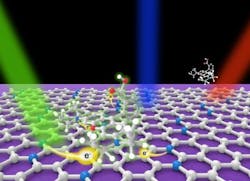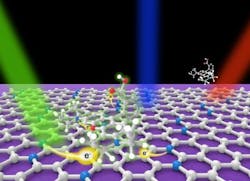Raman spectroscopy-based graphene sensor could detect viruses
An international team of researchers working at Pennsylvania State University (Penn State; State College, PA) has developed a highly sensitive chemical sensor based on Raman spectroscopy and using nitrogen (N)-doped graphene as a substrate. In this case, doping refers to introducing nitrogen atoms into the carbon structure of graphene. The technique can detect trace amounts of molecules in a solution at very low concentrations, some 10,000 times more diluted than can be seen by the naked eye, and could someday be used for detecting viruses.
Related: Biophotonic pathways to molecular diagnostics
Raman spectroscopy, an identification technique used in chemistry, materials science, and the pharmaceutical industry, can detect the unique internal vibrations of various molecules. When a laser light irradiates crystals or molecules, it scatters and shifts colors. That scattered light can be detected in the form of a Raman spectrum, which serves almost as a fingerprint for every Raman-active irradiated system.
The research team chose three types of fluorescent dye molecules for their experiments. Fluorescent dyes, which are frequently used as markers in biological experiments, are particularly hard to detect in Raman spectroscopy because the fluorescence tends to wash out the signal. However, when the dye is added to the N-doped graphene substrate, the fluorescence is quenched.
On its own, the Raman signal is so weak that many methods have been used to enhance the signal. A recently developed enhancement technique uses pristine graphene as a substrate, which can enhance the Raman signal by several orders of magnitude. In a paper describing the work, Mauricio Terrones, professor of physics, chemistry, and materials science at Penn State, and colleagues revealed that adding nitrogen atoms to the pristine graphene further enhances sensitivity and, importantly, gave a theoretical explanation for how graphene and N-doped graphene cause the enhancement.
Because of graphene's chemical inertness and biocompatibility, the team expects that the new technique will be effective in detecting trace amounts of organic molecules. Ana Laura Elias, a coauthor and research associate in Terrones' lab, is excited about the prospect of combining the technique with available portable Raman spectrometers that can be taken to remote places to detect, for instance, dangerous viruses. The fluorescent dyes they studied will make it fast and easy to see the presence of compounds inside biological cells. Because the technique is simple, it should be feasible to create an entire library of the Raman spectrum of specific molecules, Terrones says.
Researchers from Brazil, China, and Japan contributed to this work while visiting the Terrones lab at Penn State.
Full details of the work appear in the journal Science Advances; for more information, please visit http://dx.doi.org/10.1126/sciadv.1600322.

